Although it is sometimes called “slate,” the argillite stone that has been carved by Haida artists for the past two hundred years is actually a carbonaceous shale. The deposit that is found at the Slatechuck quarry near Skidegate on Haida Gwaii was transformed by very particular geological forces into a literally unique variety of argillite. This black stone is dense yet eminently carvable if one has the skill and patience, and a set of keen knives and gravers. The Haida argillite carving tradition still thrives today, thanks to skilled modern masters such as Christian White and Gary Minaker-Russ.
The earliest Haida argillite artworks date to about the late 1820s. The earliest pieces are relatively small ceremonial pipes, but very quickly Haida artists began making argillite objects primarily for trade with Euro-American visitors. They experimented with a variety of object types (pipes, figures, tableware, model totems, recorders); imagery (Haida and foreign inspired); and styles (traditional formline, naturalistic, and hybrid) throughout the 19th century and well into the 20th century. Among the most fascinating works from the early-mid 1800s are the intricate panel pipes, both Haida-motif and “ship panel pipes.”

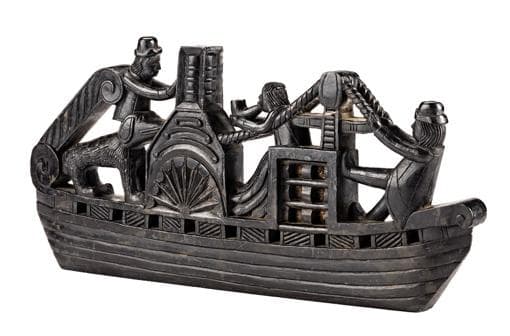
Early Haida-Motif Panel Pipe, 1830s Ship Panel Pipe, c. 1840-1860
(First Arts Auction, July 2021, Lot 54) (First Arts Auction, Dec. 2020, Lot 17)
Possibly the earliest example of Haida argillite art in this Spring’s collection is the remarkable Russian Orthodox Priest (Lot 23). This finely carved and detailed portrait-like figure – an image perhaps unique among Haida argillite figures – may date from as late as c. 1880 but quite possibly hails from decades earlier during the heyday of “ship panel pipe” and “sea captain” production (see Steven Clay Brown’s analysis in our catalogue). The priest’s elaborate cloak and tunic, and his finely chiseled facial features and beautifully coiffed hair and beard are certainly reminiscent of the best of the sea captain sculptures we have seen.

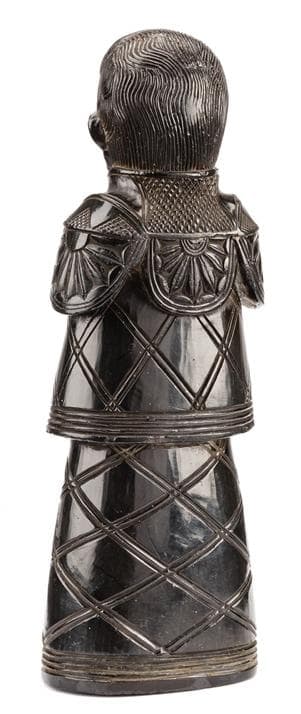
UNIDENTIFIED HAIDA ARTIST
ESTIMATE: $7,000 — $10,000
The first argillite model poles were probably carved in the 1860s; the “early period” of model pole production extends through the 1880s. Most early argillite poles are probably modelled on actual wooden poles, hence their proportions (one-to-one head and body) and cross-sections (semi-cylindrical with hollowed-out backs) typically resemble those of wooden poles. This Hollow Back Model Totem Pole (Lot 109) is a fine example from this earlier period. By the 1880s many model poles were quite large, but this one retains the modest scale of earlier examples. Its imagery and style remind us of a pole in the Reif Collection at the Royal BC Museum. [1]
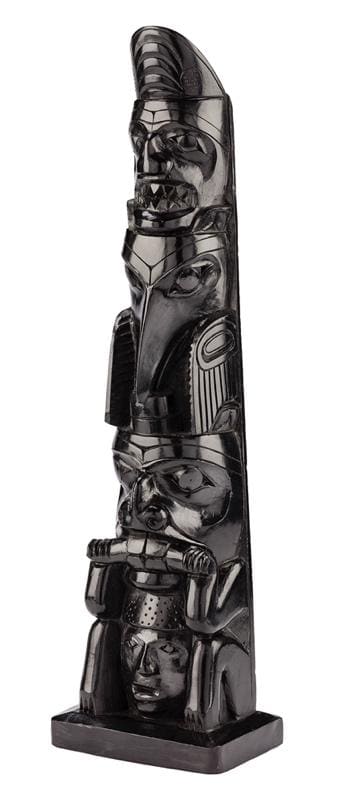

UNIDENTIFIED HAIDA ARTIST
ESTIMATE: $6,000 — $9,000
A towering figure in the history of Haida argillite art creation – and indeed the history of Northwest Coast art – Daax’igang aka Charles Edenshaw (1839-1920) is true icon of Haida art. Edenshaw’s virtuosic skill in several artistic media is legendary, as was his almost encyclopedic knowledge of Haida art history. Spanning the end of the 19th and the early 20th centuries, his art career was founded on tradition but was truly innovative. Edenshaw’s works and his versatility have inspired generations of Haida artists, and represent the gold standard among collectors of Northwest Coast art. The Vancouver Art Gallery’s major retrospective travelling exhibition of 2013, Charles Edenshaw, was accompanied by a lavish and scholarly catalogue.
This wonderful Model Totem Pole (Lot 21) was carved sometime between 1900 and 1910. As Steven Clay Brown writes in his catalogue essay for us, “Daax’igang’s argillite poles, especially in his later years, tended to be richly sculpted, with deeply carved profiles and intertwined subsidiary figures as can be seen in this example…. Edenshaw’s well-defined and developed sculpture reveals [its] images in an elegant purity, each figure comfortably ensconced in relation to the others without being cramped or bulky.”
In his essay “Will the Real Charles Edenshaw Please Stand Up: The Problem of Attribution in Northwest Coast Indian Art” for the 2013 Charles Edenshaw catalogue [2], Bill Holm writes, “Edenshaw’s sculpture, at least as represented in small poles, frontlets, and argillite and ivory carvings, exhibits features which are just as distinctive as in his flat work.” He goes on to describe an “overall feeling of movement, openness and integration of positive forms and background.” He describes the specific attributes of eyes and eye sockets, eyebrows, teeth, and ears – all of which are relevant to this exceptional pole. His description of Edenshaw’s carving of limbs is also noteworthy: “The limbs of the various creatures are rounded in cross-section. Because they are smoothly rounded and compact they have a chubby effect. They are bent at the elbows and knees, and the fingers and claws (often three in number) grasp purposefully, a detail which helps in no small measure to relate the interlocked figures to each other (p. 89).
We also note Edenshaw’s penchant for carving charmingly idiosyncratic figures – usually animals but sometimes humans – shown in quirky poses atop many if not most of his argillite and wooden model poles. The Charles Edenshaw catalogue is replete with illustrations: see figs. 3, 25, 71, 72, 79, 122, 130-134, and 171-172. Many of the animal figures are young and seemingly rambunctious or inquisitive, as is the delightful beaver in our example.
While this argillite pole is smaller than most of Edenshaw’s model poles from the 1880s, it is in fact relatively “large” for an argillite pole dated post-1890. At 10.25 inches (26 cm) in height, it is taller than or equal to nine of the dozen or so argillite poles dated c. 1890-1905 or “late 19th century” in the Charles Edenshaw book.

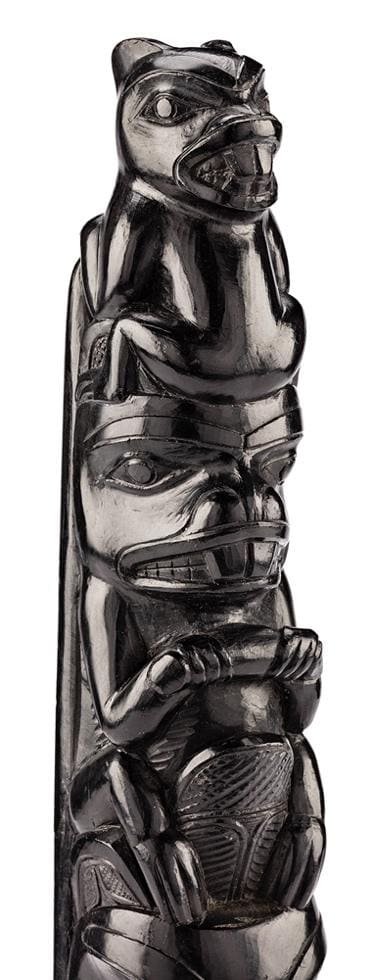
Lot 21
CHARLES EDENSHAW (DAAX’IGANG or TAHAYGEN) (1839-1920), MASSET, HAIDA GWAII
Model Totem Pole, c. 1900-10
ESTIMATE: $60,000 — $90,000
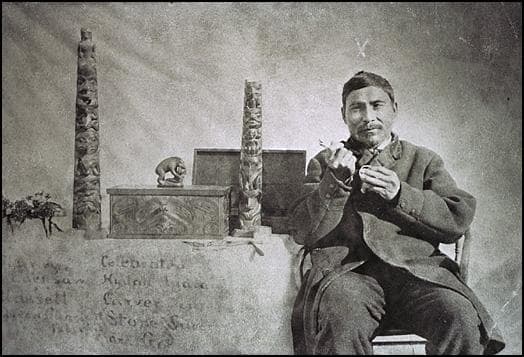
Charles Edenshaw, c. 1880 (photographer unknown, Cdn. Mus. Of History, photo 88926)
Born at Chaatl, John Cross (1867-1939) was an Eagle Chief from Skidegate. He was trained as a tattooist back in the 1870s and was thus skilled as an artist in both two and three dimensions. One of the best argillite carvers of his generation and a highly proficient metal jeweller, he did not, however, pursue his art full-time. Marius Barbeau, who interviewed the artist and wrote about him at some length, noted that Cross greatly enjoyed fishing and boatbuilding as well. [3]
This remarkable pole by John Cross packs a lot of visual punch into its twelve inches (which includes the elegant base). Both the densely packed figures and the deep arc of the pole’s cross-section are distinctive aspects of this artist’s personal style. Steven Clay Brown writes in his catalogue essay: “Here a trio of primary figures is densely overlapped with subsidiary images that weave the larger creatures together. At the top is a seated eagle with folded wings, its head leaning forward as if scanning for prey. The eagle is seated on what appears to be a whale, its pectoral fins flanking the body and its tail turned up and held within its mouth. The bird’s wings and the whale’s pectoral fins feature small formline complexes that employ a large main ovoid much wider than it is tall, an identifying marker of John Cross’s style. A man’s head and arms protrude from beneath the whale, perhaps representing Gunarnasimgyet. At the bottom of the composition is an astoundingly large bear, making a meal out of a whale. The whale’s tail is draped over the bear’s feet, its body grasped by the bear’s forelegs, over which hang the pectoral fins. The whale’s head is covered by the bear’s mouth. This pole has a flat back, and is proportioned deeper than it is wide, both of which are characteristics of a later stage in argillite pole development, perhaps around 1920.”
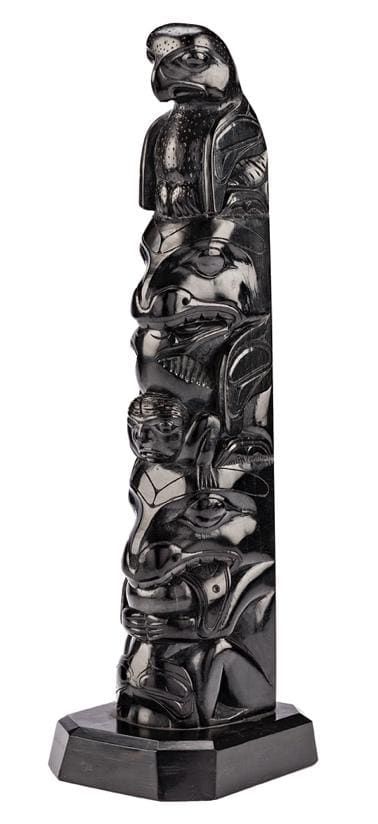
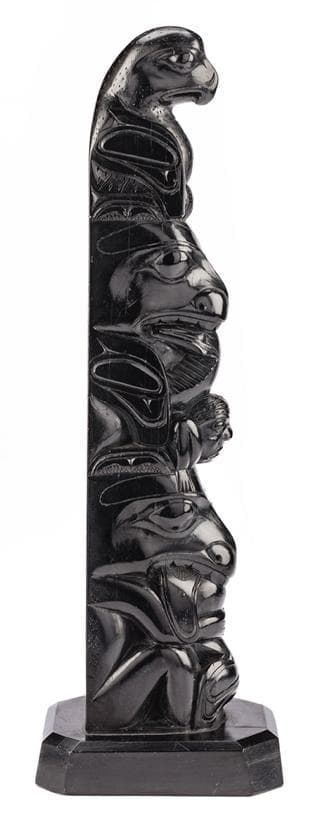
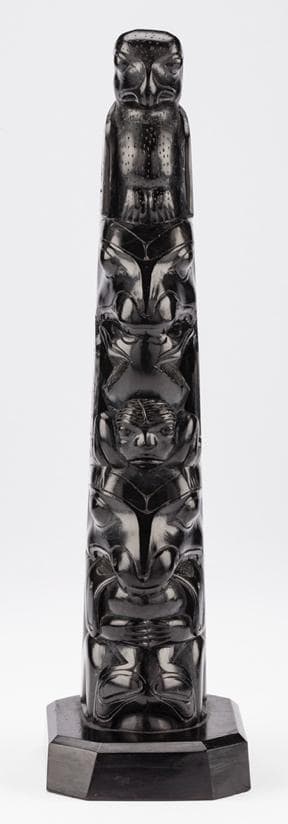
JOHN CROSS (1867-1939) SKIDEGATE, HAIDA GWAII
Model Totem Pole, c. 1920
"Captain" Andrew Brown inherited his Haida name Owt'iwans from his grandfather. An Eagle of the Gitins division from Yan, he frequently used the eagle crest. His English given name was Andrew Brown, and he was given the nickname "Captain" because he was a skilled boat-builder and shipper. He was widely known as a storyteller and humorist.
In his catalogue essay, Christopher W. Smith describes this work as a “particularly fine three-figure argillite pole” by the artist. He goes on to write: “The pole features what appears to be a female Bear holding her cub over an anthropomorphic male Bear, a likely reference to the Haida story of the Bear Mother, which was a popular motif in argillite carvings. Although unsigned, this pole is almost certainly the work of Brown and reflects an earlier, more refined style of his carving. Distinctive features of Brown’s work found on this pole include large, flat eyes with centre marks and broad, downturned mouths. Brown . . . was heavily influenced by fellow Haida carver Charles Edenshaw, a fact which can be seen on this pole by the way the bear cub breaks the bilateral symmetry of the totem pole configuration. Brown was also a friend and informant of Canadian anthropologist Marius Barbeau, who promoted and published Brown’s work in his seminal book Haida Carvers in Argillite. [4] The combination of Brown’s visibility in Barbeau’s books combined with his long career has meant that his pieces can be found in many public and private collections around the world.”
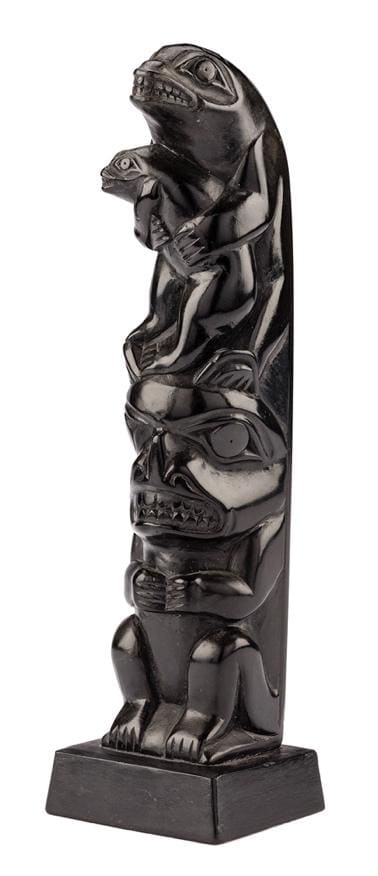


Captain Andrew Brown at his work table
(B.C. Government photo, published in Drew & Wilson, p. 246)
This Spring’s collection also features an argillite Late Trade Pipe, probably dating from the late 1880s. Regular production of this form of argillite pipe began perhaps around 1850, and lasted until the end of the 19th century. Early examples were based on European clay pipes (a bowl and long, narrow stem). Haida artists soon began adding figural embellishments that typically resembled contemporaneous ship panel pipe imagery (i.e. Euro-American rather than Haida). Later trade pipes (beginning c. 1880) depict Haida imagery almost exclusively (often illustrating the Bear Mother myth), although European faces still often embellish the bowls.
This pipe includes typical Haida imagery, but in an uncommon configuration. Rather than being in the form of a forward-facing human head, or incorporated into an animal’s body, the bowl is unadorned and in second-last position. A fully carved rear-facing eagle extends beyond the bowl, looking back at a raven and frog. The raven lies on its back and joins its beak with the mouth of the frog crouching in the bird’s belly.
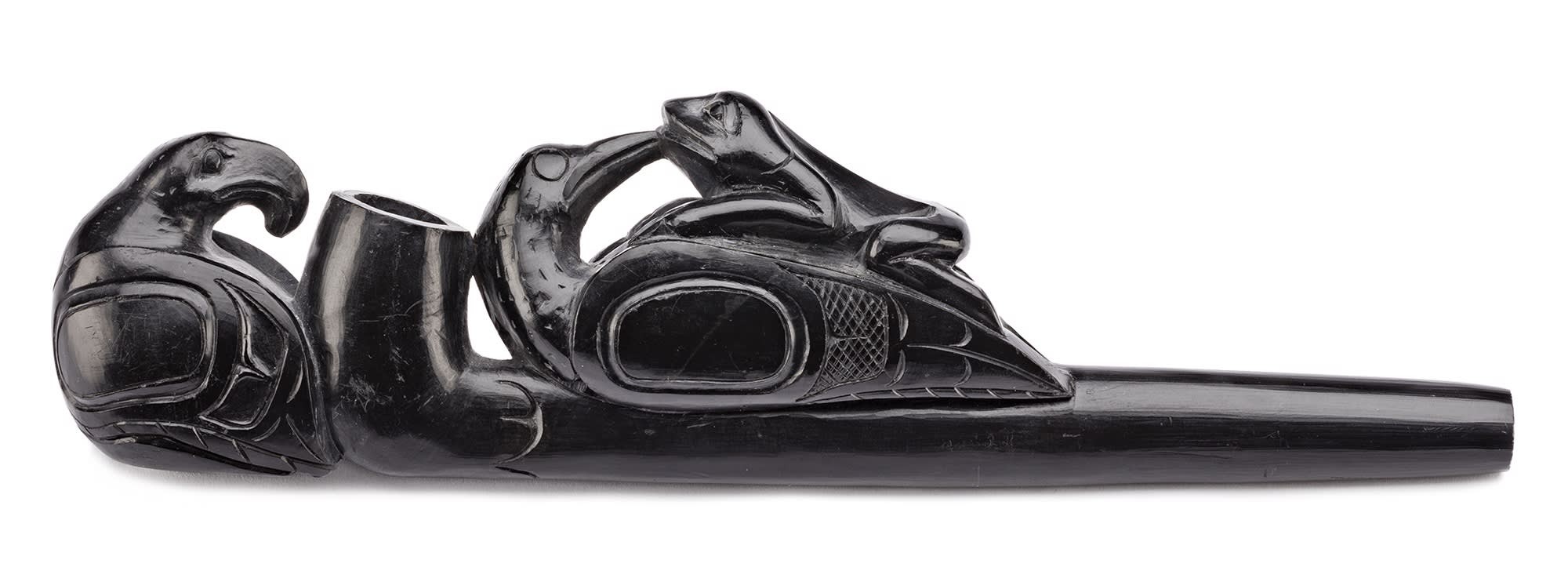

Lot 83
UNIDENTIFIED HAIDA ARTIST
End Notes
1. See Peter L. Macnair and Alan L. Hoover, The Magic Leaves: A History of Haida Argillite Carving, (Victoria: British Columbia Provincial Museum, 1984), fig. 107.
2. Bill Holm, “Will the Real Charles Edenshaw Please Stand Up: The Problem of Attribution in Northwest Coast Indian Art,” in Robin K. Wright and Daina Augaitis eds., Charles Edenshaw, (London, UK: Black Dog Publishing / Vancouver: Vancouver Art Gallery, 2013), pp. 81-89. Excerpted from the author’s essay in Donald Abbott, ed., The World is as Sharp as a Knife: An Anthology in Honour of Wilson Duff, (Victoria: British Columbia Provincial Museum, 1981:175-200).
3. Marius Barbeau, Haida Carvers in Argillite, (Ottawa: Department of Northern Affairs and Natural Resources, National Museum of Canada, Bulletin no. 139; no. 38, 1957; reprinted 1974), pp. 123-129.
4. ibid., pp. 203-207.
